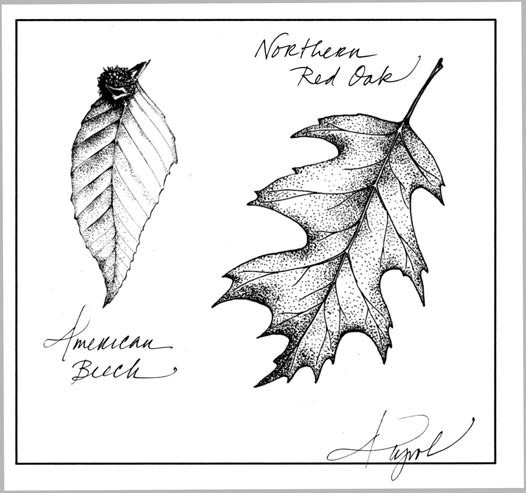
“What do you think, Chuck, oak or beech?” This was my forester asking, and my immediate response was not to say anything because I was gasping for air after pursuing him up a rocky hillside. Also, I suspected it was a question with no easy answer.
We were cruising our woodlot this past fall in preparation for drawing up a new forest management plan. “Cruising” is a forester’s term for doing an inventory of what you’ve got, and I was along for the ride, trying to help out where I could without getting in the way.
“Oak or beech,” I repeated, stalling for time, “umm, what about if we just let nature take its course here. Would that be beech?” I asked, noting a gorgeous, 24-inch specimen just uphill from where we stood.
Mimicking nature is all the fashion in forestry circles these days. The idea is to figure out how to remove useable wood from the forest in a way that mimics how trees die anyway, be it from wind or ice or fire or hurricanes. If you do this successfully, the theory goes, you should end up with the general mix of plants and animals that are native and best suited to your particular area.
Quiet from the forester. Then he asked, “how do these beech trees look to you?” I had to admit, not counting the gem of a tree right next to me, the beech trees we had seen so far looked pretty scraggly, with dying limbs, thinned crowns, and pock-marked bark. They appeared to have terrible cases of black acne.
Beech is fighting a desperate rear-guard action against a Nectria fungus that has been on the march across the Northeast since it arrived here in the 1960s. Beech is by no means out, but it’s definitely down, and it may take centuries before the beech and the Nectria reach some sort of détente, allowing beech to regain its former glory.
This is terrible news for wildlife, especially deer, bear, and turkeys, since beech trees produce some of the most nutritious nuts in the forest. It also complicates matters for landowners and foresters, who aren’t sure how much to count on beech over the near term.
As it happens, our woodlot straddles an east-west ridge. On the hot, dry, south-facing half of the property, we have lots of oak. On the cooler, wetter, north-facing half, we have beech and hemlock. The property is smack on the fabled beech/oak line, the botanical division between northern and southern New England.
North of the line, which runs across central New Hampshire, separating the southern White Mountains from the Merrimack lowlands, and then across southeastern Vermont into the Berkshires of Massachusetts, beech is a keystone species of the northern hardwood forest. South of the line, which zigs north to pick up the southern Connecticut River Valley, red oak is the signature tree of the oak/hickory forest. On our woodlot, we could theoretically have it both ways.
“Why don’t we go for beech on the north slopes and oak on the south?” I suggested, getting back to the mimicking nature idea.
“That would be a good bet,” he said, “if we knew about the future.”
Pollen records and historical documents show that the location of the beech/oak line has held steady for many centuries, despite such climate shifts as the end of the little ice age in the early 1800s. Our climate today is nearly 5 degrees Fahrenheit warmer than it was then, and the beech line hasn’t shifted. But current climate projections suggest that our climate is going to warm at least that much again, potentially upending the historical beech/oak relationship. Should we take this into account?
From a management perspective, you favor beech and oak in very different ways. If you want new beech trees to sprout, you harvest mature trees either individually or in small groups. Young beech trees are most competitive in the filtered light of a closed forest canopy. Young oak trees, on the other hand, are most competitive in full sunlight, so to ensure their future, you typically harvest mature trees in larger groups, perhaps up to a quarter acre in size. Beech, in other words, thrives in the wake of natural disturbances like small blowdowns and old tree mortality. Oak thrives in the wake of ice storms and hurricanes.
We sat down to eat some sandwiches and ponder the view, both of the forest in front of us and of the forest ahead in the future. On that afternoon, I was holding out hope for beech. But with a bust of a snow winter so far, I find myself thinking more and more about oak.

